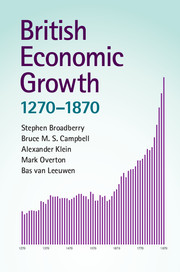Book contents
- Frontmatter
- Contents
- List of Tables
- List of Figures
- List of Appendices
- Preface and acknowledgements
- List of Weights, measures and money
- Prologue: Historical national income accounting
- Part I Measuring economic growth
- 1 Population
- 2 Agricultural land use
- 3 Agricultural production
- 4 Industrial and service-sector production
- 5 GDP and GDP per head
- Part II Analysing economic growth
- Bibliography
- Index
2 - Agricultural land use
Published online by Cambridge University Press: 05 January 2015
- Frontmatter
- Contents
- List of Tables
- List of Figures
- List of Appendices
- Preface and acknowledgements
- List of Weights, measures and money
- Prologue: Historical national income accounting
- Part I Measuring economic growth
- 1 Population
- 2 Agricultural land use
- 3 Agricultural production
- 4 Industrial and service-sector production
- 5 GDP and GDP per head
- Part II Analysing economic growth
- Bibliography
- Index
Summary
Introduction
Agriculture was for long the single largest component of the English and British economies, both in terms of its share of employment and the value of its output. The latter was a function of the amount of land under cultivation, the uses to which it was put, the productivities of crops and animals and their respective prices. The main purpose of this chapter is to describe the methods used to derive the areas under arable and grass and, in particular, the total sown acreage. The crops produced and animals stocked are the subjects of the following chapter. Along the way, it will be demonstrated that claims that the peak arable area in the medieval period may have exceeded 20 million acres (Clark, 2007a: 124) are unrealistic, since, on the best available evidence, the combined total under field crops and fallow could not have been more than 12.75 million acres. In the absence of significant food imports, this limited both the population that could be supported and the supply of kilocalories per head needed for survival. It also shaped the production choices made by agricultural producers.
Comprehensive national agricultural statistics were collected annually from 1866 and provide the starting point for calculating the acreages of arable and grass (Anon, 1968; Coppock, 1984). Together with the tithe files, which provide a precise but incomplete guide to the share of land in each county devoted to arable production during the 1830s (Kain, 1986; Overton, 1986), they are used to provide a nineteenth-century benchmark. The chapter proceeds as follows. After a discussion of the potential agricultural area of England in Section 2.2, Section 2.3 reviews the arable acreage by county from the tithe files of the 1830s and from the agricultural statistics of 1871. Section 2.4 then examines changes in land use between 1290 and 1871, while Section 2.5 presents county-level estimates of the arable acreage in 1290. Section 2.6 provides a further cross-check by examining changes in land use between 1086 and 1290. Finally, Section 2.7 provides estimates of land use for a number of benchmark years between 1270 and 1871.
- Type
- Chapter
- Information
- British Economic Growth, 1270–1870 , pp. 46 - 79Publisher: Cambridge University PressPrint publication year: 2015



